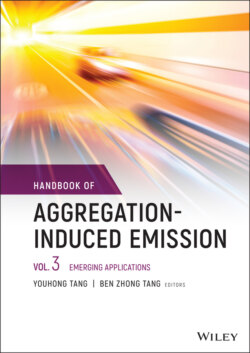Читать книгу Handbook of Aggregation-Induced Emission, Volume 3 - Группа авторов - Страница 22
1.3.2 Aggregation‐induced Delayed Fluorescent Emitters
ОглавлениеTADF or E‐type delayed fluorescent emitters can also achieve 100% IQE, and these emitters tend to have a small energy between S1 and T1 states (ΔEST) [21] to enable upconverting triplet excitons into singlet ones via the process of RISC under external heat [113]. Early in 1961, Parker and Hatchard have already discovered this phenomenon in the eosin dye [114]; however, it is not until 2009 when Adachi group utilized the TADF emitters Sn(IV)‐complexes to fabricate the first TADF OLEDs [21]. In last decade, the TADF emitters have seen a rapid progress in terms of both category [115] and efficiency [116], and they are on their way for replacing phosphorescent emitters and conventional fluorescent materials, referred to as the third‐generation emitters for OLED devices [117]. Among these emitters, the emitters with both TADF and AIE propriety have already been introduced and have attracted tremendous attention, because they can prepare highly efficient OLEDs without doping process [92].
The first emitters with both AIE and TADF properties applied in OLED devices were reported by Yasuda et al. in 2016, as organic–inorganic compounds of o‐carborane derivatives PCZ‐CB‐TRZ, PCZ‐CB‐PCZ, and TPA‐CB‐TRZ (Figure 1.7), with emission peaking at wavelengths of 557, 624, and 571 nm, respectively, and also high solid‐state PLQYs of 97, 55, and 94% in neat films, respectively, compared with their PLQY below 3% in solution. Their nondoped OLED devices can reach the maximum EQEs of 11, 10.1, and 9.2%, respectively [118]. Zhao and Tang et al. synthesized and reported a series of AIE and TADF luminogens, as AIDF emitters [119]. For example, they reported three unsymmetrical D‐A‐D′ structured AIDF emitters of DBT‐BZ‐DMAC, DBT‐BZ‐PXZ, and DBT‐BZ‐PTZ (Figure 1.7), and their doped OLEDs exhibited highest EQE of 19.2% with larger efficiency roll‐off, while their nondoped counterparts showed the data of up to 14.2%, but with slight efficiency roll‐off [120, 121]. Chen et al. reported another AIE‐TADF materials AI‐Cz and AI‐TBCz (Figure 1.7), based on which OLEDs gave stable emission and low efficiency roll‐off, with maximum EQEs of 23.2 and 21.1%, respectively [122].
Figure 1.7 Chemical structures of aggregation‐induced delayed fluorescent emitters.
